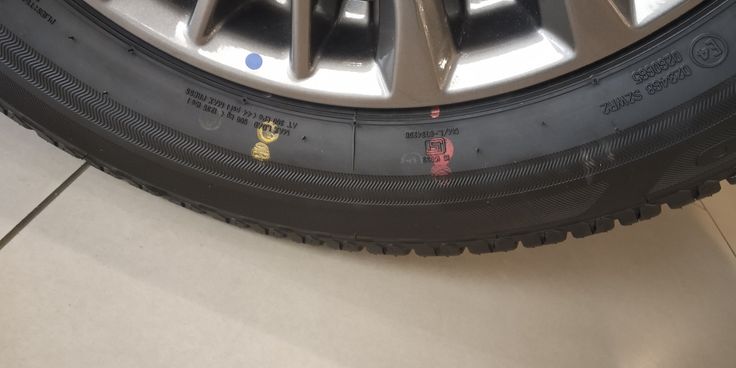Last Updated on November 10, 2024
Red and Yellow Dots on Tires Explained
When you order new tires online, you will typically search by tire size, type of tire, reviews, price, reviews, and delivery dates. Here’s a fun fact: once ordered and received, you will notice red and yellow dot markings on the sidewall. If you’re unfamiliar with these dots, they are simply another tool the industry uses to ensure your tires are mounted and aligned properly.
Below, we’ll explore the distinctions between the red and yellow dots.
The Red Dot
The red dot on a tire represents the maximum radial force variation (RFV) point. Radial force variation measures the variation in stiffness around the tire’s circumference. In simpler terms, this is the point on the tire where the sidewall is the stiffest. If the tire is not balanced correctly, this stiffness can cause it to exert more force on the road as it rotates, potentially leading to vibrations or uneven tire wear.
Why RFV Matters
RFV is particularly important for fast-driving, high-performance vehicles, where even a minor imbalance could negatively impact handling and safety.
By properly aligning the red dot with the valve stem (which is typically the heaviest part of the wheel due to the presence of the valve and other components), the technician can counterbalance the tire’s stiffest point with the wheel’s heaviest point. This alignment helps to ensure a smoother ride and reduces the likelihood of vibrations.
The Yellow Dot
The yellow dot on a tire indicates its lightest point. It is used in conjunction with the wheel’s heaviest point, which is usually the valve stem. Aligning the yellow dot with the valve stem minimizes the imbalance of the tire and wheel assembly, which reduces the need for additional balancing weights.
The Importance of the Light Point
Tires and wheels are rarely perfectly balanced on their own. By identifying and marking the lightest point on the tire, manufacturers make it easier for technicians to achieve a balanced assembly. When the yellow dot is aligned with the valve stem, the technician can often achieve a near-perfect balance with minimal added weights, resulting in a more efficient and cost-effective balancing process.
When to Focus on the Yellow Dot
The yellow dot is the most critical marking for everyday drivers. It is the key to having a well-balanced tire, a smoother ride, and better fuel efficiency, which results in even tire wear. This is especially important for people driving long distances, as it reduces strain on the suspension and steering components.
Balancing the Red and Yellow Dots: What to Do When Both Are Present
If a tire has both a red and yellow dot, it may be more difficult for the technician to align both. In these cases, the technician will prioritize one over the other based on your vehicle’s specific needs and driver preferences. However, most manufacturers recommend prioritizing the red dot (RFV) alignment for performance and high-speed applications. Aligning the yellow dot with the valve stem is sufficient for normal everyday driving and also simplifies the mounting process without sacrificing day-to-day performance.
When Both Dots Matter
In some cases, both dots may need to be considered, such as high-performance vehicles or those with sensitive suspension systems. In these situations, technicians may use a combination of alignment techniques, such as aligning the red dot with the valve stem and then using additional weights to achieve a perfect balance.
The Impact of Proper Dot Alignment on Tire Performance
Proper alignment of the red and yellow dots during tire mounting can significantly impact overall tire performance. Drivers can enjoy a range of benefits, including:
- Improved Ride Quality: A smoother, quieter ride with fewer vibrations.
- Reduced Tire Wear: Minimizing imbalances and RFV reduces uneven tire wear, extending the tire’s lifespan.
- Better Fuel Efficiency: A balanced tire requires less rotating energy, improving fuel efficiency and lowering operating costs.
Though it may seem minor, understanding the difference between red and yellow dots can be essential for the longevity and optimal performance of your tires.
-
Automotive Specialist
-
Proofreader
-
Writer










